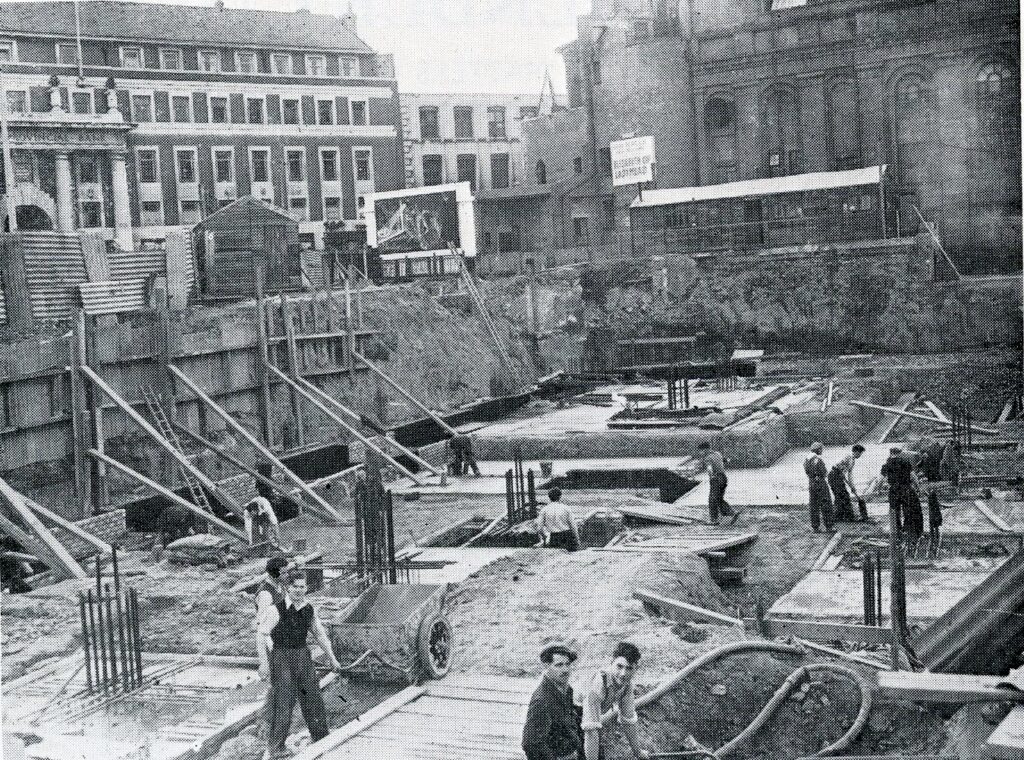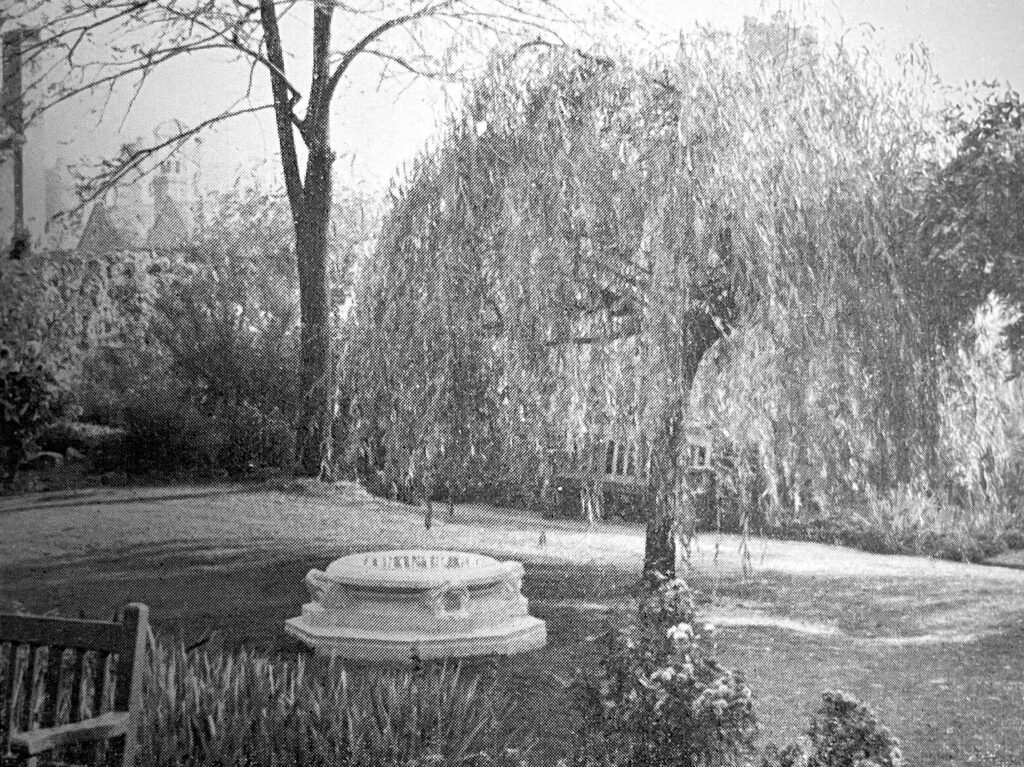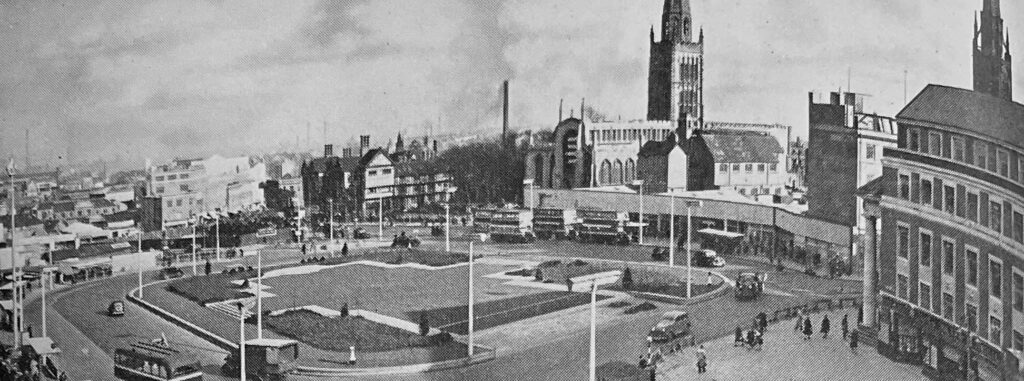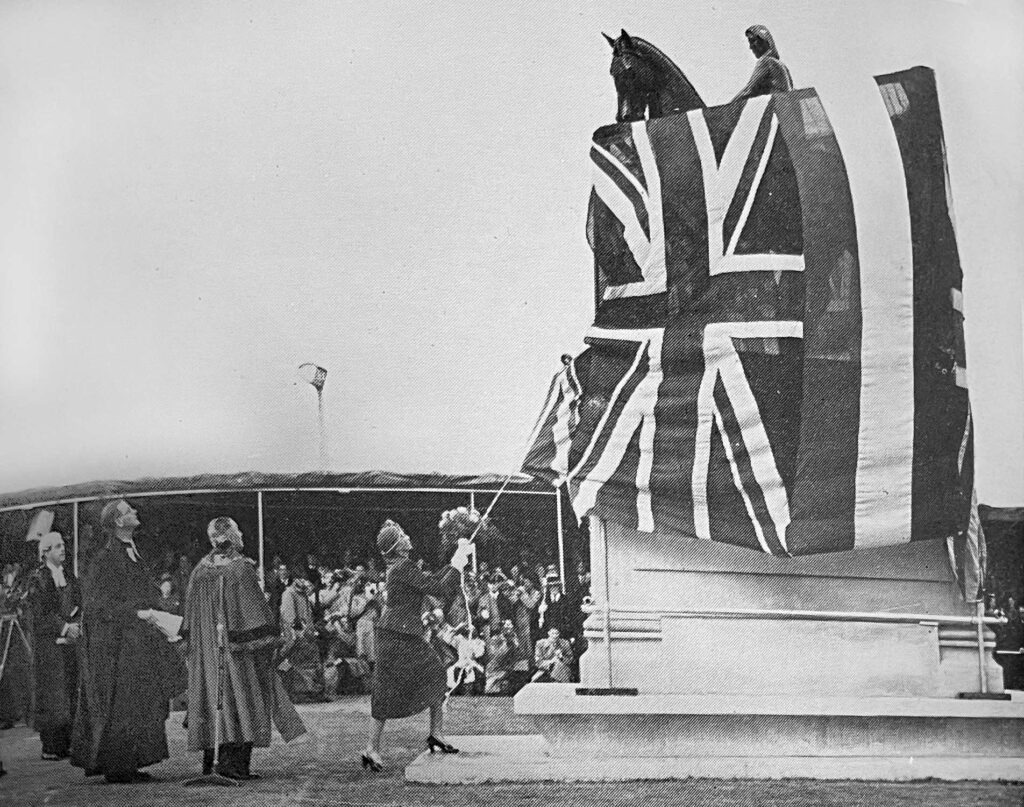(from Alfred Herbert News Vol 30 No 5 Sept-Oct 1956)
Historian and CovSoc Committee member, David Fry, has been studying past editions of the Alfred Herbert Newsletter. These newsletters are much more than just a works newsletter and reveal a lot about the thinking in the city at the time they were written. The article below is extracted from 1956 editions of their Newsletter, looking back at a year of activity in the busy post-war city, and is written in the words of the Alfred Herbert’s employee. David writes….
The changes to the city centre continue against the turmoil on national events …
The first day of 1949 brought good news from Buckingham Palace for it was announced that H.M. the King had recovered sufficiently from his recent illness to be able to go to Sandringham.
But the end of the month brought another announcement of a very different kind, one that made old Coventrians shake their heads with despondency. It was to the effect that the Riley Motor Company, a firm which had made quality cars in Coventry for nearly half a century, was severing its connection with the city and moving to Abingdon.
First Thomas Stevens and now the Riley!

It was true that unemployment hardly existed at this time in Coventry; nevertheless the loss of these old firms was greatly to be regretted.
Shortly after this the Top o’ the Town once more became a centre of interest to everyone for excavations began on the site where Block B, the first of the magnificent buildings for the new Broadgate was to be erected.
A few days later, on February 19th, the country was horrified to learn of what seemed to be an absolutely inexplicable .accident over Coventry.
Shortly before 10a.m. a B.E.A. Dakota on a flight from Northolt to Glasgow had collided with a R.A.F. Anson on a training flight with the result that 14 were killed.
It was nevertheless only by a miracle that the death toll was not greater, for had the accident occurred over a more densely populated area of the city the wreckage, which had fallen at the back of the Exhall Hospital, would have undoubtedly proved far more dangerous than it had.
On the 23rd another step was taken away from the austerities of war-time for on that date sweet rationing was declared at an end. “Or”, asked the pessimists, “is it?”
Why must history be so full of irritating pessimists? Irritating, not because they are pessimists, but because they are so very often right!
And now, once more, it seemed that the dreary pattern of 1947 and 1948 “years of bitter disillusionment and disappointment” was about to repeat itself as over the industrial scene was cast the shadow of more industrial unrest.
On March 2nd there was a lightning strike of the Transport Maintenance Section which, although it lasted only two days practically paralysed the city’s transport arrangements.
It was not long however before brighter news obliterated the memory of the strike. On March 12th it was announced that the King had had an operation on his right leg to improve the circulation and that the result was entirely satisfactory. On the 15th clothes rationing was abolished, and two days later motorists were delighted to hear that their petrol allowance for June, July and August had been doubled.
And yet further interesting news. The City Architect proposed that that master-piece of timekeeping, the Market Hall Clock, which had come unscathed through the Blitz, should be placed on the new Broadgate Bridge that was to span Hertford Street. He also proposed that the figures of Lady Godiva and Peeping Tom should be incorporated “making it comparable in interest with some the world’s most famous public timepieces”.
This proposal was received with great interest and everyone looked forward to a masterpiece of design which would combine the dignity of the upsoaring Market Hall Clock with the intricate grace and elegance of moving figures such as Coventry, its long tradition of craftsmanship, would undoubtedly produce.
In the middle of the month still more. Shop-from news was forthcoming shopkeepers and advertisers were advised that from April 2nd until October 2nd the ban on electric lighting for shop windows and electric signs would be lifted. While Coventry could not, of course, compare with the flashing gaiety of Piccadilly there was nevertheless very soon an almost forgotten air of brightness in the city as shop windows; blazed forth and neon signs glowed in many different colours.
But the effect of this brightness was soon dimmed when it was announced on March 19th that the weekly meat ration would be cut to 10d. per person. As a result, queues formed early and quickly at the city’s only horse meat butcher in Castle Street, and many a “beefsteak” that was served to the man of the house was undoubtedly horse meat, a delicacy more appreciated on the Continent than it has been here.
And now almost savagely the pattern of 1947 and 1948 began its disheartening repetition. On March 15th forty sheet metal workers at the Jaguar went on strike for a week, on the 18th Fisher & Ludlow said that 240 workpeople would have to be stopped, while on the 22nd the Ferguson Tractor Company announced that 1,200 men would have to lose their jobs due to lack of orders.
On the 24th an unofficial strike brought production to a standstill at Binley and Keresley pits and, although the strike only lasted two days, 10,000 tons of coal was lost from the two collieries and a subsequent coal shortage hit the Coventry area.
On April 11th 6,200 London dockers went on strike against the dismissal of 32 men and by the following day 13,134 dockers were idle. Fortunately, like the Coventry strike, it lasted only four days, but, also like the Coventry strike, it filled the country with uneasy forebodings which were only too soon to be realised.
As a contrast to this industrial gloom, the weather at Easter produced a real heat wave surpassing anything ever recorded in Coventry for the time of the year. On Sunday the temperature soared to 77°F and hours of sunshine were recorded during the week.
And now came the turn of the pessimists. “Or was it ?” they had queried on February 23rd. It wasn’t! On April 24th it was announced that sweet rationing was to be re-imposed.
Once more a blow was struck at the country’s economy. On May 2nd in a dispute over concessionary coal 3,000 miners in Lancashire came out on strike and by the 10th 50,000 were idle.
On May 12th the Municipal elections took place. Although the Labour Party in Coventry lost only one seat it was obvious that as a party it was fast losing the confidence of the country for the final results showed that while the Labour Party had lost 715 seats, the Conservatives had gained 805.
May 16th was received with very mixed feelings by the whole country.
On that day came the good news that the Lancashire miners had gone back to work but it was followed almost immediately by the extremely bad news that 1,200 Avonmouth dockers had gone on strike. On the 27th 1,000 Liverpool dockers joined the strike and by June 6th a total of 8,000 were out. This was so serious an interruption to the country’s trade that troops had to be called in to load and unload ships until the strikers returned to work on the 15th.

During the following month Sir Alfred Herbert, the eminent Coventry industrialist, celebrated his 50th anniversary as President of the Coventry Engineering Society. At a luncheon which he gave to the members Sir Alfred announced that his Company had arranged for a series of lectures to be given during the next five years by leading experts in their own particular fields.
The Society, to mark this unique occasion, presented Sir Alfred with a handmade book, containing all the signatures of the members, a commemorative plaque to be placed in one Technical College, and a bird-bath in stone for the Lady Herbert Garden.

And still the disrupting and devastating influence of strikes continued to harass the country.
On June 28th 8,600 dockers from the London Docks went on strike and by July 7th troops had to be called in to unload food and goods. At midnight on July 1 a State of Emergency was declared in view of the dockers’ decision to continue the strike which by now involved 10,000 men. As 112 ships were, by this time, lying idle, 2,000 troops were called in to deal with them, a figure that was increased to 4,500 two days later.
By July 19th over 15,000 dockers were on strike and 6,800 troops were struggling to cope with loads of food that threatened to go bad and so deprive the nation of its already meagre rations and goods for export that were piling up until they seemed likely to choke the docks.
Not until July 25th did this strike, which had done incalculable harm to the nation, come to an end.
Within a month another strike had broken out. In Yorkshire 600 pitwinders went on strike with the result that by August 22nd 52 coal mines had closed down and 20,000 miners were idle. Although this strike lasted only four days it nevertheless meant the loss of 322,000 tons of badly needed coal.
And now, a long last, a long-awaited event took place in Coventry.
For some weeks workmen had been observed building in the centre of Broadgate island the plinth on which the statue of Lady Godiva was to stand.

This statue, given by Mr. W. H. Bassett Green and executed by Sir William Reid Dick, had already, in its preparatory stages, given rise to a great deal of criticism, so that everyone was anxious to see the final result.
At noon on October 22nd Mrs. Lewis Douglas, the wife of the American Ambassador to Great Britain, performed the unveiling ceremony before a huge crowd, after which she was entertained to a civic luncheon in St. Mary’s Hall at which many distinguished guests were present.
Did the statue please or not?

There were, of course, some criticisms. The horse was of the wrong breed, Godiva looked a little brazen (as the statue was in bronze this criticism was hard to answer!) and the statue should very obviously have been done in white marble. These criticisms were not very serious, however, and the statue soon became accepted for what it was, the centre-piece of the new city. But another and totally unexpected criticism was suddenly voiced. The most important statue in Coventry had been placed in the middle of a huge island upon which the public were requested not to trespass and the whole was surrounded by a mad swirling mass of traffic so that even when viewed from the nearest pavement Godiva could hardly be seen without the aid of a telescope.
The succeeding years have, so far, failed to silence this criticism nor yet find an answer to it.
As a further advance to the rebuilding of the city, on November 11th the Provost of Coventry the Very Rev. R. T. Howard announced that he had received a cheque for 18,000 dollars (£6,500) from the Canadian Royal Society of Organists towards the cost of a new organ for Coventry Cathedral.
At 11.15p.m. on the night of November 15th a most disastrous fire broke out in the Co-operative Grocery Warehouse in Upper York Street. Despite the combined efforts of several fire brigades the entire stock of rationed goods and seasonal goods for Christmas, including one and a quarter million cigarettes, was destroyed. It was estimated that the blaze, the largest in Coventry since the war, resulted in a loss of £250,000.
By now winter was approaching and it seemed that Nature was about to reproach man for not making the most of his opportunities of mining the precious warmth-giving coal, for on December 9th 1.5 in. of snow fell in a very short time. Fortunately, however, a rapid rise in temperature soon cleared the streets.

December 19th was a very important date for many Coventry households, for on that day the Postmaster General, Mr. Wilfred Paling opened the new television transmitter at Sutton Coldfield. This transmitter, the most powerful in the world, enabled Coventry for the first time to get perfect television reception.
Two days later all the children of Coventry —and doubtless many of the adults—were greatly thrilled when the Mayor, Alderman Hammond, switched on the Christmas illuminations. The magnificent sets, had been loaned by Blackpool Corporation, created cheerful blazes of light in many parts of the city.
By the 22nd Coventry had taken on a very festive appearance. Markets, shops and stalls were filled to overflowing with everything needed to make Christmas what it should be in fact there was more Food and drink than there had been at any time since the war.

Even the weather co-operated for it was one of the mildest Christmases ever experienced with temperatures soaring into the 50’s.
The nation as a whole had received many set-backs during 1949, chiefly owing to industrial unrest but this hardly affected Coventry so by the end of year the Coventry Evening Telegraph could say “And in industry Coventry’s 1949 record is not excelled by any other city in the country. Good wages, no unemployment, no serious labour unrest, closer relations between employers and employees and splendid achievements in production for export have strengthened Coventry’s position as one of the most important cities in the country”.
